Strategic Change Management & Implementation at CBK: A Report
VerifiedAdded on 2023/06/06
|18
|5760
|346
Report
AI Summary
This report provides an analysis of strategic change management at the Commercial Bank of Kuwait (CBK), focusing on the need for change driven by technological advancements, economic factors, and shifting customer trends. It examines the application of change management models, specifically Porras and Robertson's Model and McKinsey's 7-S Framework, to understand how these models can facilitate effective implementation of technological changes within the bank. The report identifies key drivers for change, including globalization, digitalization, and external competitive pressures, and discusses the implications of non-responsiveness to these changes. It elaborates on significant types of organizational changes—transitional, transformational, and developmental—and their effects on the bank's performance. Furthermore, it emphasizes the importance of addressing internal and external stakeholders' concerns, managing potential resistance to change, and leveraging change management models to ensure successful implementation and achieve strategic objectives such as enhanced customer experience and reduced operational costs. This document is available on Desklib, a platform offering study tools and solved assignments for students.
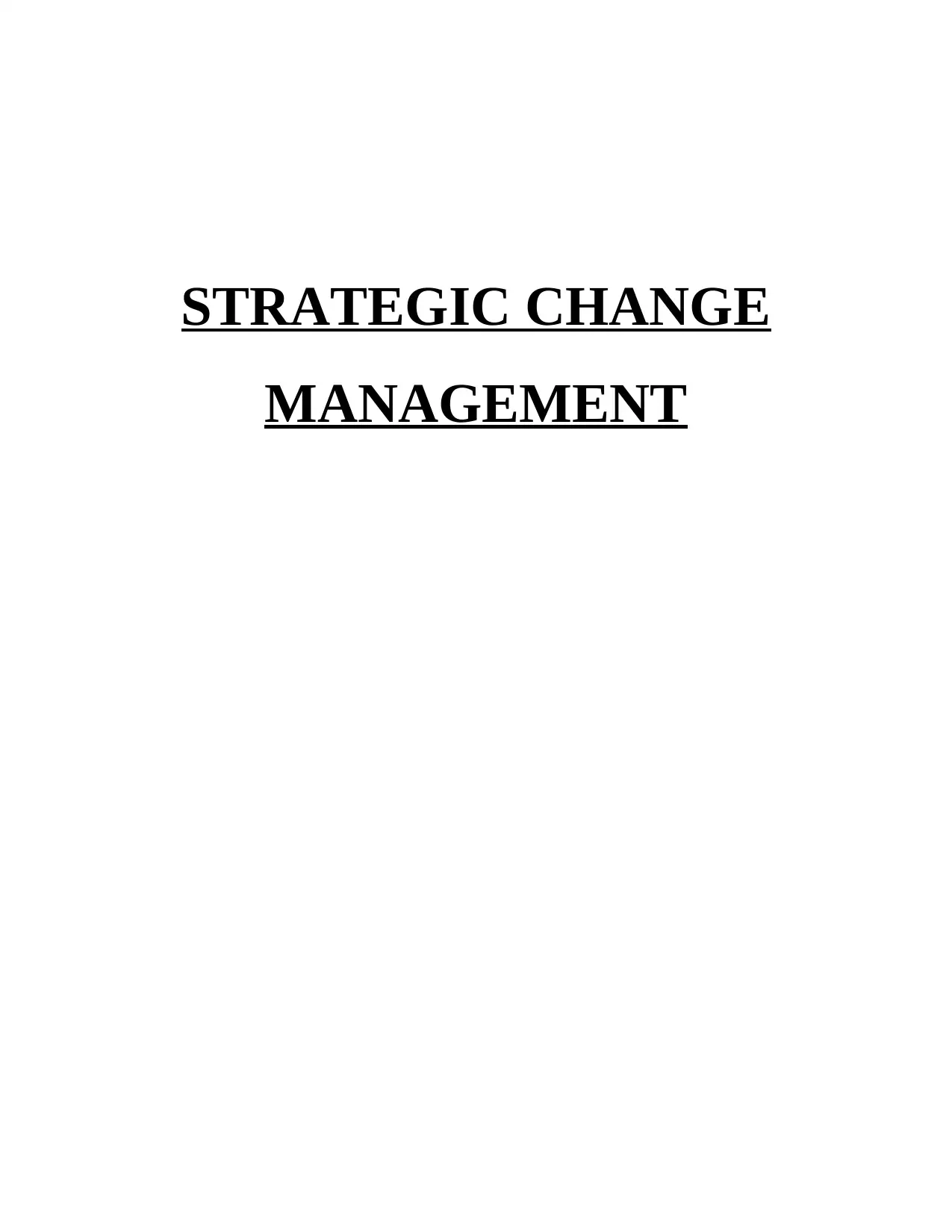
STRATEGIC CHANGE
MANAGEMENT
MANAGEMENT
Paraphrase This Document
Need a fresh take? Get an instant paraphrase of this document with our AI Paraphraser

1.0 Executive Summary.
The Commercial Bank of Kuwait is improving clients and reducing operational costs in
bank and concentrating on technological happening. Also, to coordinate online and mobile
banking services as customer care, all goals are dependent on this as the power of the bank. As
well the technical advancement, economic process, shifting customer trends and digital change it
is included by the runners of technological alteration. Furthermore, Forwarding the technologies
can be connected with competition as failure to borrow current implement bring out the bank to
danger of decreasing competitive benefit.
The both frameworks Porras and Robertson's and McKinsey's 7s framework are planned
modification management model, the before framework be given that organizational alteration
straightly affects various elements inside the work setting, which bend the impact employees
behaviour is good or bad. Furthermore, it concerns McKinsey's 7s models, smooth factors
connected to human resource like employees and value system have the most important effect in
the organization, the Commercial Bank of Kuwait has to evaluate how technological factors
relating to human resource like workers.
The Commercial Bank of Kuwait is improving clients and reducing operational costs in
bank and concentrating on technological happening. Also, to coordinate online and mobile
banking services as customer care, all goals are dependent on this as the power of the bank. As
well the technical advancement, economic process, shifting customer trends and digital change it
is included by the runners of technological alteration. Furthermore, Forwarding the technologies
can be connected with competition as failure to borrow current implement bring out the bank to
danger of decreasing competitive benefit.
The both frameworks Porras and Robertson's and McKinsey's 7s framework are planned
modification management model, the before framework be given that organizational alteration
straightly affects various elements inside the work setting, which bend the impact employees
behaviour is good or bad. Furthermore, it concerns McKinsey's 7s models, smooth factors
connected to human resource like employees and value system have the most important effect in
the organization, the Commercial Bank of Kuwait has to evaluate how technological factors
relating to human resource like workers.
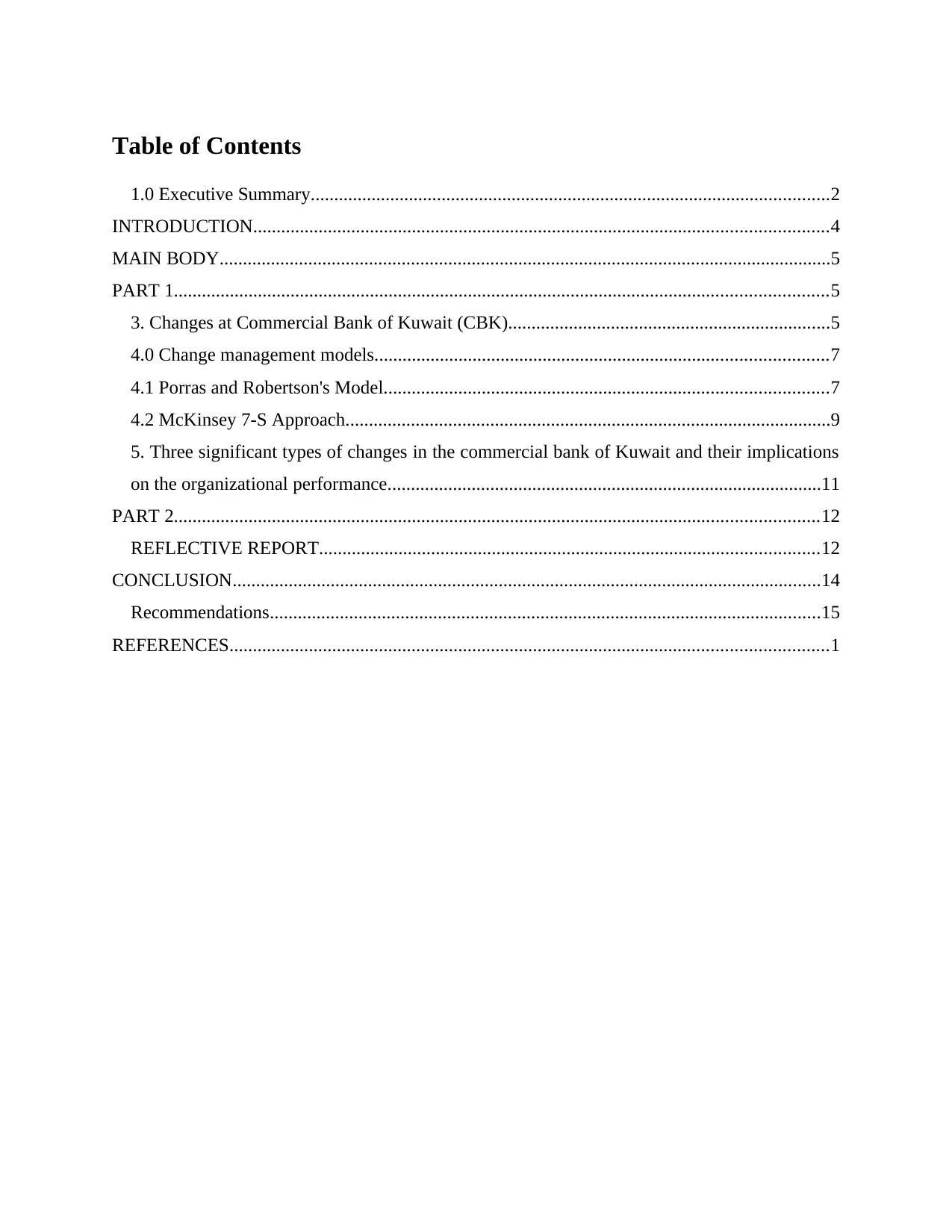
Table of Contents
1.0 Executive Summary...............................................................................................................2
INTRODUCTION...........................................................................................................................4
MAIN BODY...................................................................................................................................5
PART 1............................................................................................................................................5
3. Changes at Commercial Bank of Kuwait (CBK).....................................................................5
4.0 Change management models.................................................................................................7
4.1 Porras and Robertson's Model...............................................................................................7
4.2 McKinsey 7-S Approach........................................................................................................9
5. Three significant types of changes in the commercial bank of Kuwait and their implications
on the organizational performance.............................................................................................11
PART 2..........................................................................................................................................12
REFLECTIVE REPORT...........................................................................................................12
CONCLUSION..............................................................................................................................14
Recommendations......................................................................................................................15
REFERENCES................................................................................................................................1
1.0 Executive Summary...............................................................................................................2
INTRODUCTION...........................................................................................................................4
MAIN BODY...................................................................................................................................5
PART 1............................................................................................................................................5
3. Changes at Commercial Bank of Kuwait (CBK).....................................................................5
4.0 Change management models.................................................................................................7
4.1 Porras and Robertson's Model...............................................................................................7
4.2 McKinsey 7-S Approach........................................................................................................9
5. Three significant types of changes in the commercial bank of Kuwait and their implications
on the organizational performance.............................................................................................11
PART 2..........................................................................................................................................12
REFLECTIVE REPORT...........................................................................................................12
CONCLUSION..............................................................................................................................14
Recommendations......................................................................................................................15
REFERENCES................................................................................................................................1
⊘ This is a preview!⊘
Do you want full access?
Subscribe today to unlock all pages.

Trusted by 1+ million students worldwide
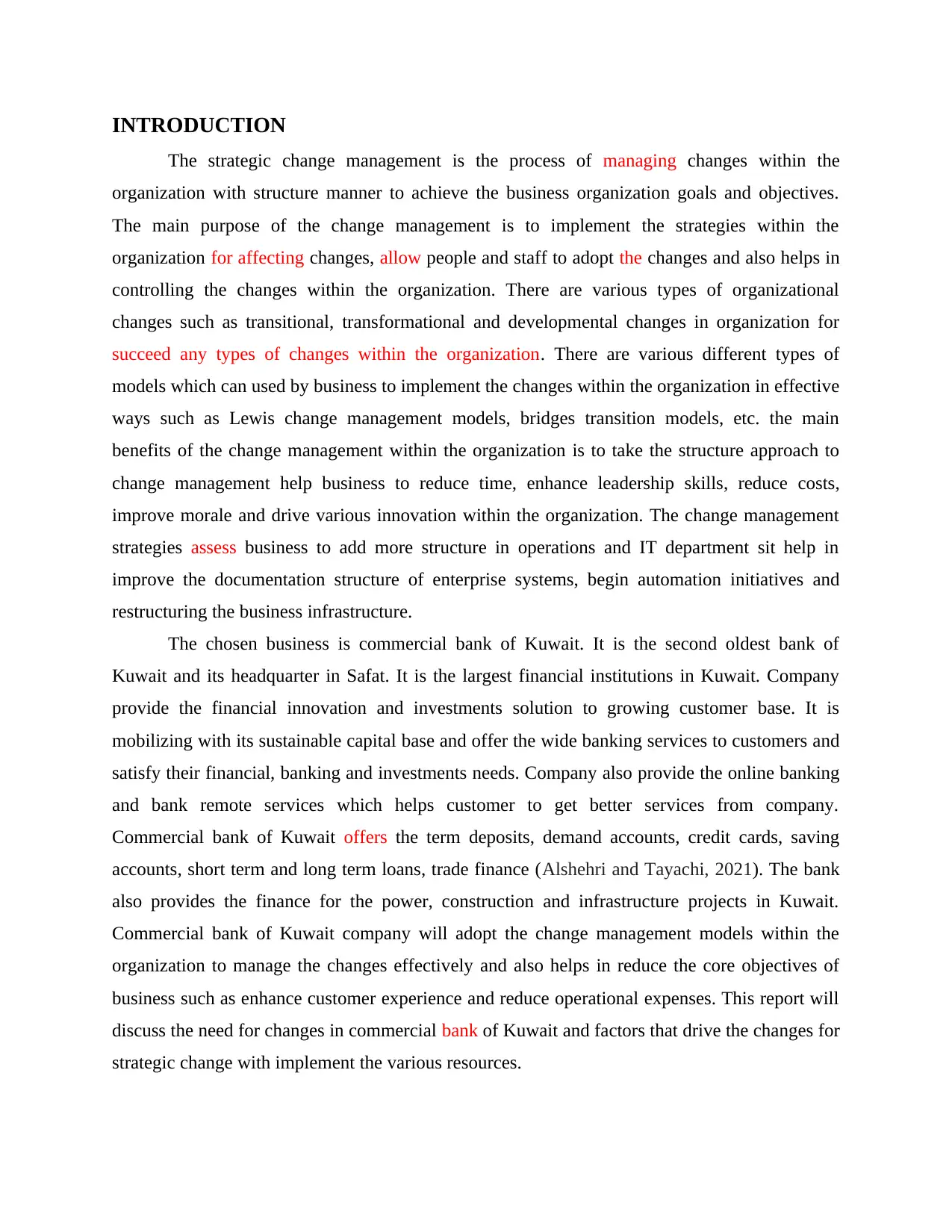
INTRODUCTION
The strategic change management is the process of managing changes within the
organization with structure manner to achieve the business organization goals and objectives.
The main purpose of the change management is to implement the strategies within the
organization for affecting changes, allow people and staff to adopt the changes and also helps in
controlling the changes within the organization. There are various types of organizational
changes such as transitional, transformational and developmental changes in organization for
succeed any types of changes within the organization. There are various different types of
models which can used by business to implement the changes within the organization in effective
ways such as Lewis change management models, bridges transition models, etc. the main
benefits of the change management within the organization is to take the structure approach to
change management help business to reduce time, enhance leadership skills, reduce costs,
improve morale and drive various innovation within the organization. The change management
strategies assess business to add more structure in operations and IT department sit help in
improve the documentation structure of enterprise systems, begin automation initiatives and
restructuring the business infrastructure.
The chosen business is commercial bank of Kuwait. It is the second oldest bank of
Kuwait and its headquarter in Safat. It is the largest financial institutions in Kuwait. Company
provide the financial innovation and investments solution to growing customer base. It is
mobilizing with its sustainable capital base and offer the wide banking services to customers and
satisfy their financial, banking and investments needs. Company also provide the online banking
and bank remote services which helps customer to get better services from company.
Commercial bank of Kuwait offers the term deposits, demand accounts, credit cards, saving
accounts, short term and long term loans, trade finance (Alshehri and Tayachi, 2021). The bank
also provides the finance for the power, construction and infrastructure projects in Kuwait.
Commercial bank of Kuwait company will adopt the change management models within the
organization to manage the changes effectively and also helps in reduce the core objectives of
business such as enhance customer experience and reduce operational expenses. This report will
discuss the need for changes in commercial bank of Kuwait and factors that drive the changes for
strategic change with implement the various resources.
The strategic change management is the process of managing changes within the
organization with structure manner to achieve the business organization goals and objectives.
The main purpose of the change management is to implement the strategies within the
organization for affecting changes, allow people and staff to adopt the changes and also helps in
controlling the changes within the organization. There are various types of organizational
changes such as transitional, transformational and developmental changes in organization for
succeed any types of changes within the organization. There are various different types of
models which can used by business to implement the changes within the organization in effective
ways such as Lewis change management models, bridges transition models, etc. the main
benefits of the change management within the organization is to take the structure approach to
change management help business to reduce time, enhance leadership skills, reduce costs,
improve morale and drive various innovation within the organization. The change management
strategies assess business to add more structure in operations and IT department sit help in
improve the documentation structure of enterprise systems, begin automation initiatives and
restructuring the business infrastructure.
The chosen business is commercial bank of Kuwait. It is the second oldest bank of
Kuwait and its headquarter in Safat. It is the largest financial institutions in Kuwait. Company
provide the financial innovation and investments solution to growing customer base. It is
mobilizing with its sustainable capital base and offer the wide banking services to customers and
satisfy their financial, banking and investments needs. Company also provide the online banking
and bank remote services which helps customer to get better services from company.
Commercial bank of Kuwait offers the term deposits, demand accounts, credit cards, saving
accounts, short term and long term loans, trade finance (Alshehri and Tayachi, 2021). The bank
also provides the finance for the power, construction and infrastructure projects in Kuwait.
Commercial bank of Kuwait company will adopt the change management models within the
organization to manage the changes effectively and also helps in reduce the core objectives of
business such as enhance customer experience and reduce operational expenses. This report will
discuss the need for changes in commercial bank of Kuwait and factors that drive the changes for
strategic change with implement the various resources.
Paraphrase This Document
Need a fresh take? Get an instant paraphrase of this document with our AI Paraphraser
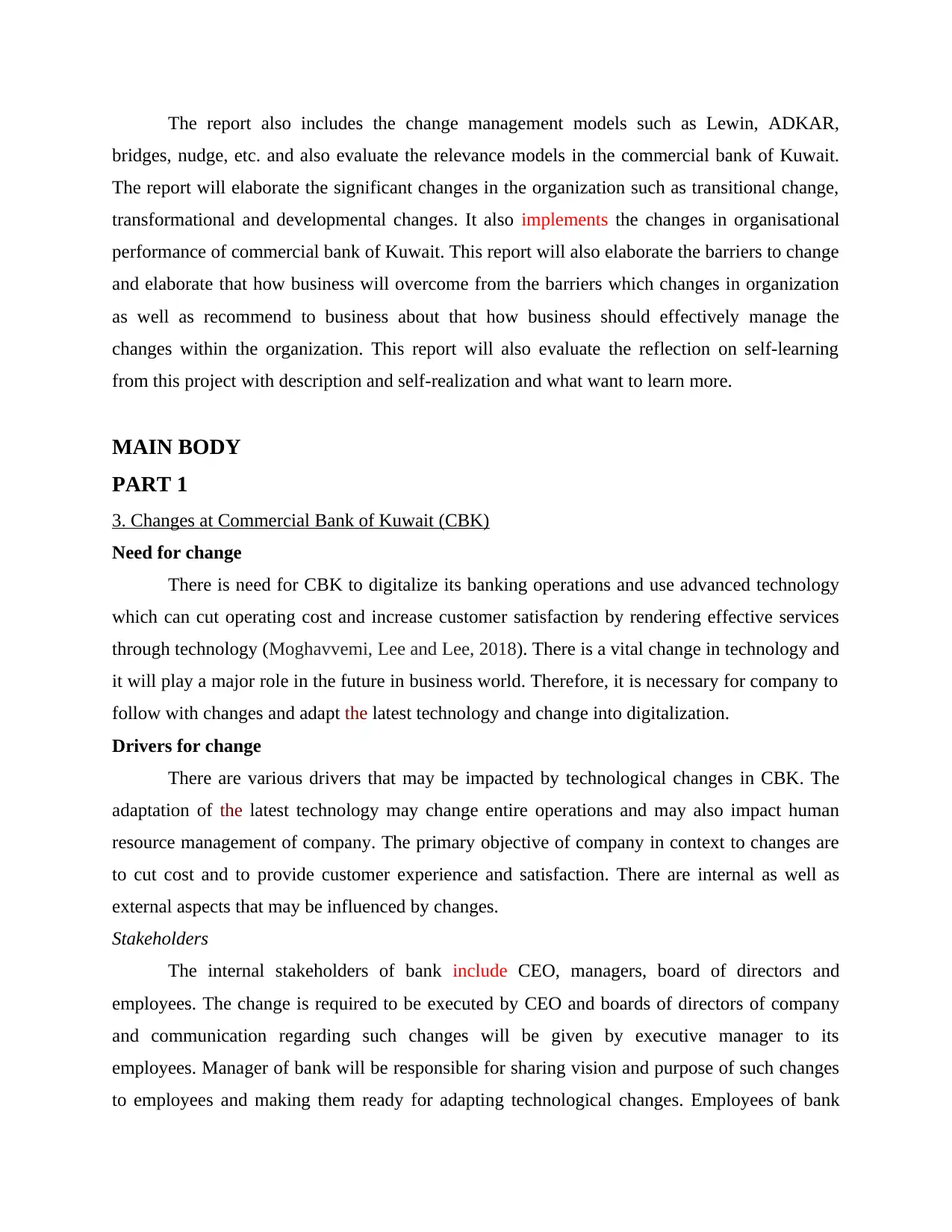
The report also includes the change management models such as Lewin, ADKAR,
bridges, nudge, etc. and also evaluate the relevance models in the commercial bank of Kuwait.
The report will elaborate the significant changes in the organization such as transitional change,
transformational and developmental changes. It also implements the changes in organisational
performance of commercial bank of Kuwait. This report will also elaborate the barriers to change
and elaborate that how business will overcome from the barriers which changes in organization
as well as recommend to business about that how business should effectively manage the
changes within the organization. This report will also evaluate the reflection on self-learning
from this project with description and self-realization and what want to learn more.
MAIN BODY
PART 1
3. Changes at Commercial Bank of Kuwait (CBK)
Need for change
There is need for CBK to digitalize its banking operations and use advanced technology
which can cut operating cost and increase customer satisfaction by rendering effective services
through technology (Moghavvemi, Lee and Lee, 2018). There is a vital change in technology and
it will play a major role in the future in business world. Therefore, it is necessary for company to
follow with changes and adapt the latest technology and change into digitalization.
Drivers for change
There are various drivers that may be impacted by technological changes in CBK. The
adaptation of the latest technology may change entire operations and may also impact human
resource management of company. The primary objective of company in context to changes are
to cut cost and to provide customer experience and satisfaction. There are internal as well as
external aspects that may be influenced by changes.
Stakeholders
The internal stakeholders of bank include CEO, managers, board of directors and
employees. The change is required to be executed by CEO and boards of directors of company
and communication regarding such changes will be given by executive manager to its
employees. Manager of bank will be responsible for sharing vision and purpose of such changes
to employees and making them ready for adapting technological changes. Employees of bank
bridges, nudge, etc. and also evaluate the relevance models in the commercial bank of Kuwait.
The report will elaborate the significant changes in the organization such as transitional change,
transformational and developmental changes. It also implements the changes in organisational
performance of commercial bank of Kuwait. This report will also elaborate the barriers to change
and elaborate that how business will overcome from the barriers which changes in organization
as well as recommend to business about that how business should effectively manage the
changes within the organization. This report will also evaluate the reflection on self-learning
from this project with description and self-realization and what want to learn more.
MAIN BODY
PART 1
3. Changes at Commercial Bank of Kuwait (CBK)
Need for change
There is need for CBK to digitalize its banking operations and use advanced technology
which can cut operating cost and increase customer satisfaction by rendering effective services
through technology (Moghavvemi, Lee and Lee, 2018). There is a vital change in technology and
it will play a major role in the future in business world. Therefore, it is necessary for company to
follow with changes and adapt the latest technology and change into digitalization.
Drivers for change
There are various drivers that may be impacted by technological changes in CBK. The
adaptation of the latest technology may change entire operations and may also impact human
resource management of company. The primary objective of company in context to changes are
to cut cost and to provide customer experience and satisfaction. There are internal as well as
external aspects that may be influenced by changes.
Stakeholders
The internal stakeholders of bank include CEO, managers, board of directors and
employees. The change is required to be executed by CEO and boards of directors of company
and communication regarding such changes will be given by executive manager to its
employees. Manager of bank will be responsible for sharing vision and purpose of such changes
to employees and making them ready for adapting technological changes. Employees of bank
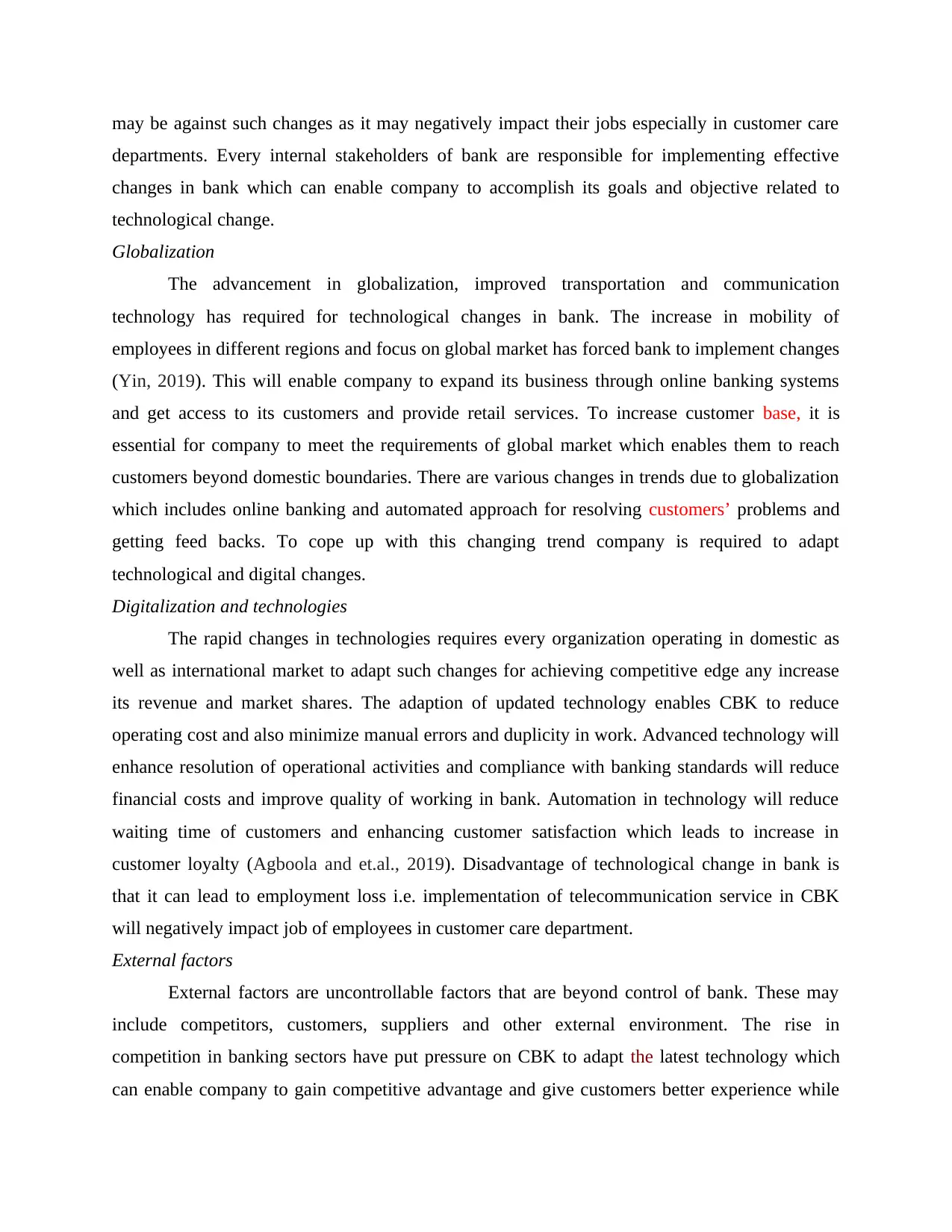
may be against such changes as it may negatively impact their jobs especially in customer care
departments. Every internal stakeholders of bank are responsible for implementing effective
changes in bank which can enable company to accomplish its goals and objective related to
technological change.
Globalization
The advancement in globalization, improved transportation and communication
technology has required for technological changes in bank. The increase in mobility of
employees in different regions and focus on global market has forced bank to implement changes
(Yin, 2019). This will enable company to expand its business through online banking systems
and get access to its customers and provide retail services. To increase customer base, it is
essential for company to meet the requirements of global market which enables them to reach
customers beyond domestic boundaries. There are various changes in trends due to globalization
which includes online banking and automated approach for resolving customers’ problems and
getting feed backs. To cope up with this changing trend company is required to adapt
technological and digital changes.
Digitalization and technologies
The rapid changes in technologies requires every organization operating in domestic as
well as international market to adapt such changes for achieving competitive edge any increase
its revenue and market shares. The adaption of updated technology enables CBK to reduce
operating cost and also minimize manual errors and duplicity in work. Advanced technology will
enhance resolution of operational activities and compliance with banking standards will reduce
financial costs and improve quality of working in bank. Automation in technology will reduce
waiting time of customers and enhancing customer satisfaction which leads to increase in
customer loyalty (Agboola and et.al., 2019). Disadvantage of technological change in bank is
that it can lead to employment loss i.e. implementation of telecommunication service in CBK
will negatively impact job of employees in customer care department.
External factors
External factors are uncontrollable factors that are beyond control of bank. These may
include competitors, customers, suppliers and other external environment. The rise in
competition in banking sectors have put pressure on CBK to adapt the latest technology which
can enable company to gain competitive advantage and give customers better experience while
departments. Every internal stakeholders of bank are responsible for implementing effective
changes in bank which can enable company to accomplish its goals and objective related to
technological change.
Globalization
The advancement in globalization, improved transportation and communication
technology has required for technological changes in bank. The increase in mobility of
employees in different regions and focus on global market has forced bank to implement changes
(Yin, 2019). This will enable company to expand its business through online banking systems
and get access to its customers and provide retail services. To increase customer base, it is
essential for company to meet the requirements of global market which enables them to reach
customers beyond domestic boundaries. There are various changes in trends due to globalization
which includes online banking and automated approach for resolving customers’ problems and
getting feed backs. To cope up with this changing trend company is required to adapt
technological and digital changes.
Digitalization and technologies
The rapid changes in technologies requires every organization operating in domestic as
well as international market to adapt such changes for achieving competitive edge any increase
its revenue and market shares. The adaption of updated technology enables CBK to reduce
operating cost and also minimize manual errors and duplicity in work. Advanced technology will
enhance resolution of operational activities and compliance with banking standards will reduce
financial costs and improve quality of working in bank. Automation in technology will reduce
waiting time of customers and enhancing customer satisfaction which leads to increase in
customer loyalty (Agboola and et.al., 2019). Disadvantage of technological change in bank is
that it can lead to employment loss i.e. implementation of telecommunication service in CBK
will negatively impact job of employees in customer care department.
External factors
External factors are uncontrollable factors that are beyond control of bank. These may
include competitors, customers, suppliers and other external environment. The rise in
competition in banking sectors have put pressure on CBK to adapt the latest technology which
can enable company to gain competitive advantage and give customers better experience while
⊘ This is a preview!⊘
Do you want full access?
Subscribe today to unlock all pages.

Trusted by 1+ million students worldwide
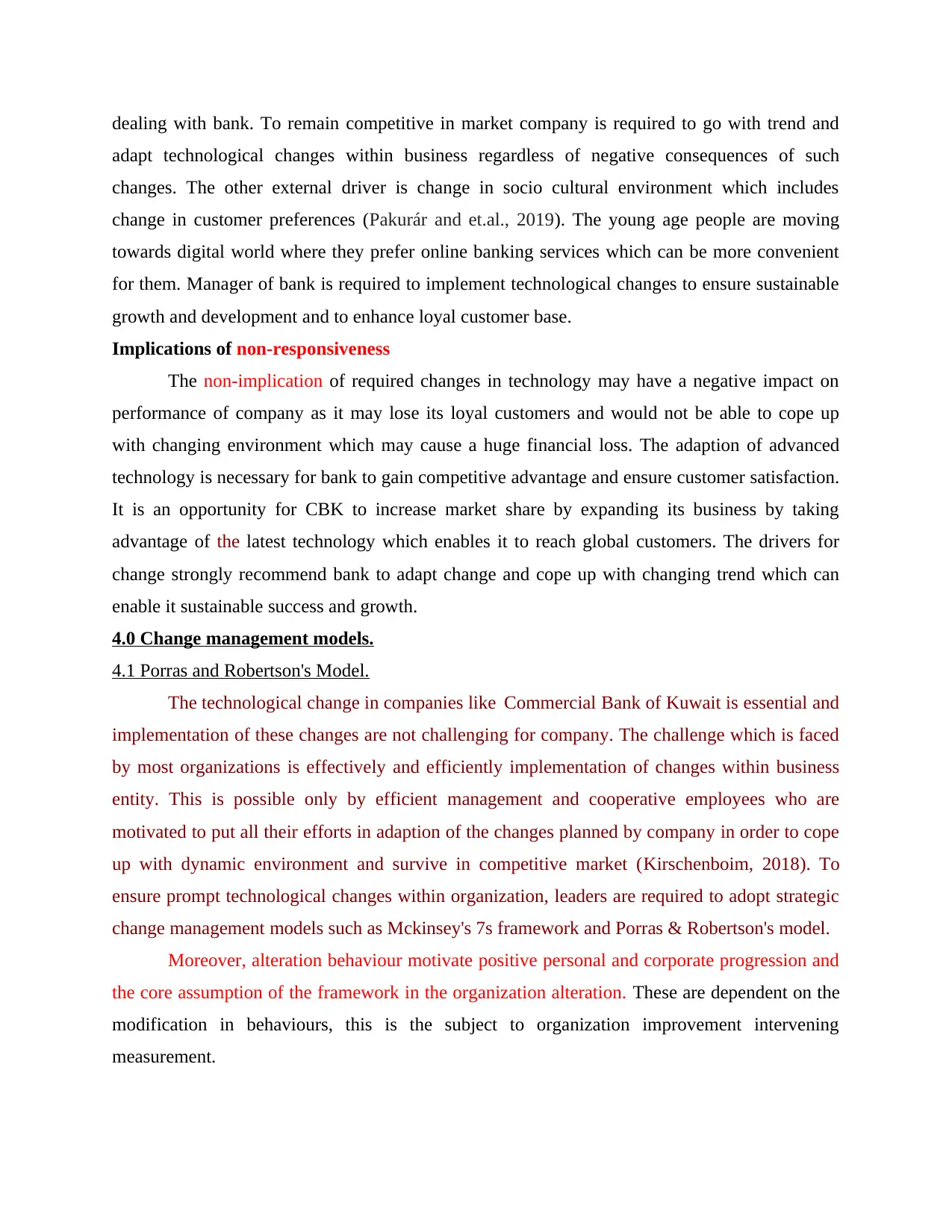
dealing with bank. To remain competitive in market company is required to go with trend and
adapt technological changes within business regardless of negative consequences of such
changes. The other external driver is change in socio cultural environment which includes
change in customer preferences (Pakurár and et.al., 2019). The young age people are moving
towards digital world where they prefer online banking services which can be more convenient
for them. Manager of bank is required to implement technological changes to ensure sustainable
growth and development and to enhance loyal customer base.
Implications of non-responsiveness
The non-implication of required changes in technology may have a negative impact on
performance of company as it may lose its loyal customers and would not be able to cope up
with changing environment which may cause a huge financial loss. The adaption of advanced
technology is necessary for bank to gain competitive advantage and ensure customer satisfaction.
It is an opportunity for CBK to increase market share by expanding its business by taking
advantage of the latest technology which enables it to reach global customers. The drivers for
change strongly recommend bank to adapt change and cope up with changing trend which can
enable it sustainable success and growth.
4.0 Change management models.
4.1 Porras and Robertson's Model.
The technological change in companies like Commercial Bank of Kuwait is essential and
implementation of these changes are not challenging for company. The challenge which is faced
by most organizations is effectively and efficiently implementation of changes within business
entity. This is possible only by efficient management and cooperative employees who are
motivated to put all their efforts in adaption of the changes planned by company in order to cope
up with dynamic environment and survive in competitive market (Kirschenboim, 2018). To
ensure prompt technological changes within organization, leaders are required to adopt strategic
change management models such as Mckinsey's 7s framework and Porras & Robertson's model.
Moreover, alteration behaviour motivate positive personal and corporate progression and
the core assumption of the framework in the organization alteration. These are dependent on the
modification in behaviours, this is the subject to organization improvement intervening
measurement.
adapt technological changes within business regardless of negative consequences of such
changes. The other external driver is change in socio cultural environment which includes
change in customer preferences (Pakurár and et.al., 2019). The young age people are moving
towards digital world where they prefer online banking services which can be more convenient
for them. Manager of bank is required to implement technological changes to ensure sustainable
growth and development and to enhance loyal customer base.
Implications of non-responsiveness
The non-implication of required changes in technology may have a negative impact on
performance of company as it may lose its loyal customers and would not be able to cope up
with changing environment which may cause a huge financial loss. The adaption of advanced
technology is necessary for bank to gain competitive advantage and ensure customer satisfaction.
It is an opportunity for CBK to increase market share by expanding its business by taking
advantage of the latest technology which enables it to reach global customers. The drivers for
change strongly recommend bank to adapt change and cope up with changing trend which can
enable it sustainable success and growth.
4.0 Change management models.
4.1 Porras and Robertson's Model.
The technological change in companies like Commercial Bank of Kuwait is essential and
implementation of these changes are not challenging for company. The challenge which is faced
by most organizations is effectively and efficiently implementation of changes within business
entity. This is possible only by efficient management and cooperative employees who are
motivated to put all their efforts in adaption of the changes planned by company in order to cope
up with dynamic environment and survive in competitive market (Kirschenboim, 2018). To
ensure prompt technological changes within organization, leaders are required to adopt strategic
change management models such as Mckinsey's 7s framework and Porras & Robertson's model.
Moreover, alteration behaviour motivate positive personal and corporate progression and
the core assumption of the framework in the organization alteration. These are dependent on the
modification in behaviours, this is the subject to organization improvement intervening
measurement.
Paraphrase This Document
Need a fresh take? Get an instant paraphrase of this document with our AI Paraphraser
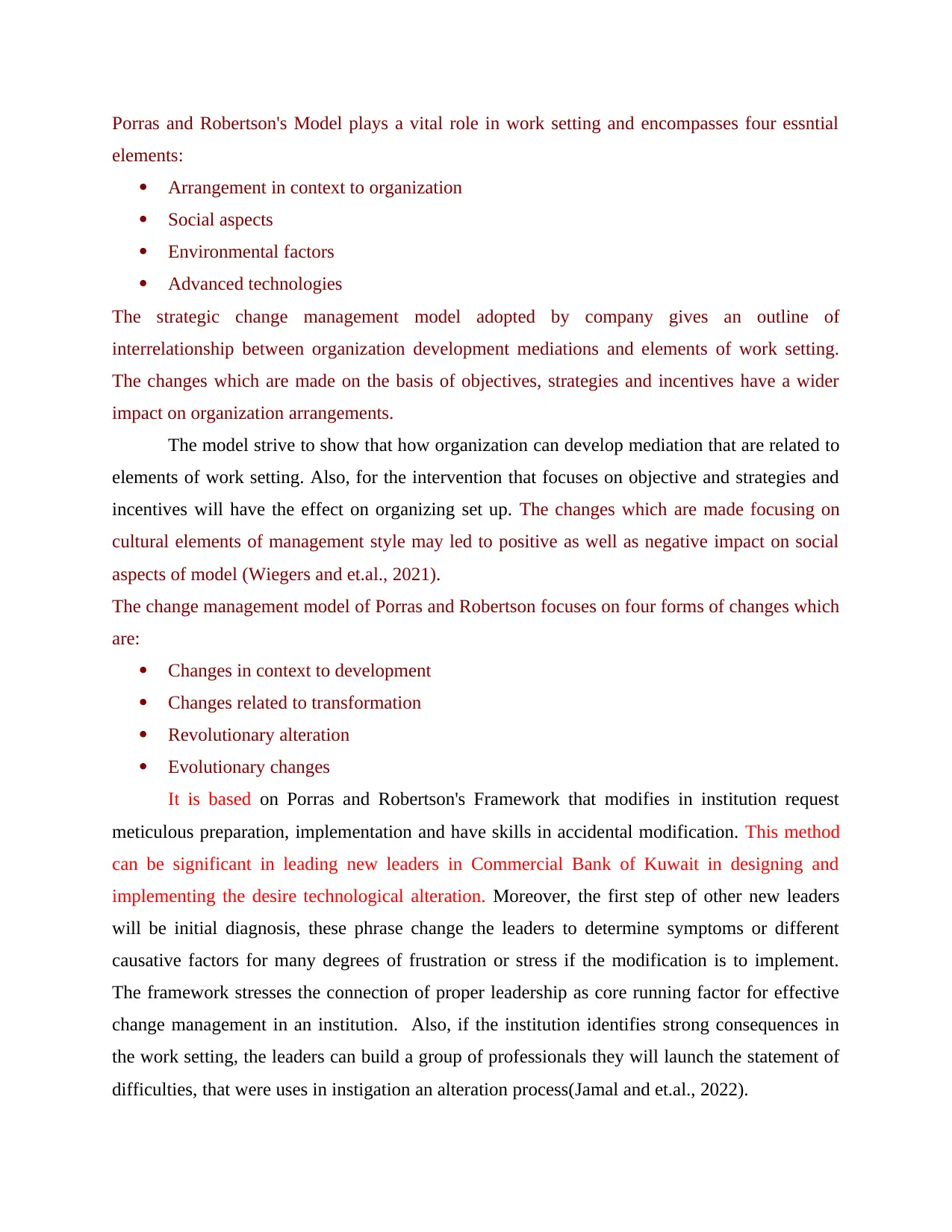
Porras and Robertson's Model plays a vital role in work setting and encompasses four essntial
elements:
Arrangement in context to organization
Social aspects
Environmental factors
Advanced technologies
The strategic change management model adopted by company gives an outline of
interrelationship between organization development mediations and elements of work setting.
The changes which are made on the basis of objectives, strategies and incentives have a wider
impact on organization arrangements.
The model strive to show that how organization can develop mediation that are related to
elements of work setting. Also, for the intervention that focuses on objective and strategies and
incentives will have the effect on organizing set up. The changes which are made focusing on
cultural elements of management style may led to positive as well as negative impact on social
aspects of model (Wiegers and et.al., 2021).
The change management model of Porras and Robertson focuses on four forms of changes which
are:
Changes in context to development
Changes related to transformation
Revolutionary alteration
Evolutionary changes
It is based on Porras and Robertson's Framework that modifies in institution request
meticulous preparation, implementation and have skills in accidental modification. This method
can be significant in leading new leaders in Commercial Bank of Kuwait in designing and
implementing the desire technological alteration. Moreover, the first step of other new leaders
will be initial diagnosis, these phrase change the leaders to determine symptoms or different
causative factors for many degrees of frustration or stress if the modification is to implement.
The framework stresses the connection of proper leadership as core running factor for effective
change management in an institution. Also, if the institution identifies strong consequences in
the work setting, the leaders can build a group of professionals they will launch the statement of
difficulties, that were uses in instigation an alteration process(Jamal and et.al., 2022).
elements:
Arrangement in context to organization
Social aspects
Environmental factors
Advanced technologies
The strategic change management model adopted by company gives an outline of
interrelationship between organization development mediations and elements of work setting.
The changes which are made on the basis of objectives, strategies and incentives have a wider
impact on organization arrangements.
The model strive to show that how organization can develop mediation that are related to
elements of work setting. Also, for the intervention that focuses on objective and strategies and
incentives will have the effect on organizing set up. The changes which are made focusing on
cultural elements of management style may led to positive as well as negative impact on social
aspects of model (Wiegers and et.al., 2021).
The change management model of Porras and Robertson focuses on four forms of changes which
are:
Changes in context to development
Changes related to transformation
Revolutionary alteration
Evolutionary changes
It is based on Porras and Robertson's Framework that modifies in institution request
meticulous preparation, implementation and have skills in accidental modification. This method
can be significant in leading new leaders in Commercial Bank of Kuwait in designing and
implementing the desire technological alteration. Moreover, the first step of other new leaders
will be initial diagnosis, these phrase change the leaders to determine symptoms or different
causative factors for many degrees of frustration or stress if the modification is to implement.
The framework stresses the connection of proper leadership as core running factor for effective
change management in an institution. Also, if the institution identifies strong consequences in
the work setting, the leaders can build a group of professionals they will launch the statement of
difficulties, that were uses in instigation an alteration process(Jamal and et.al., 2022).
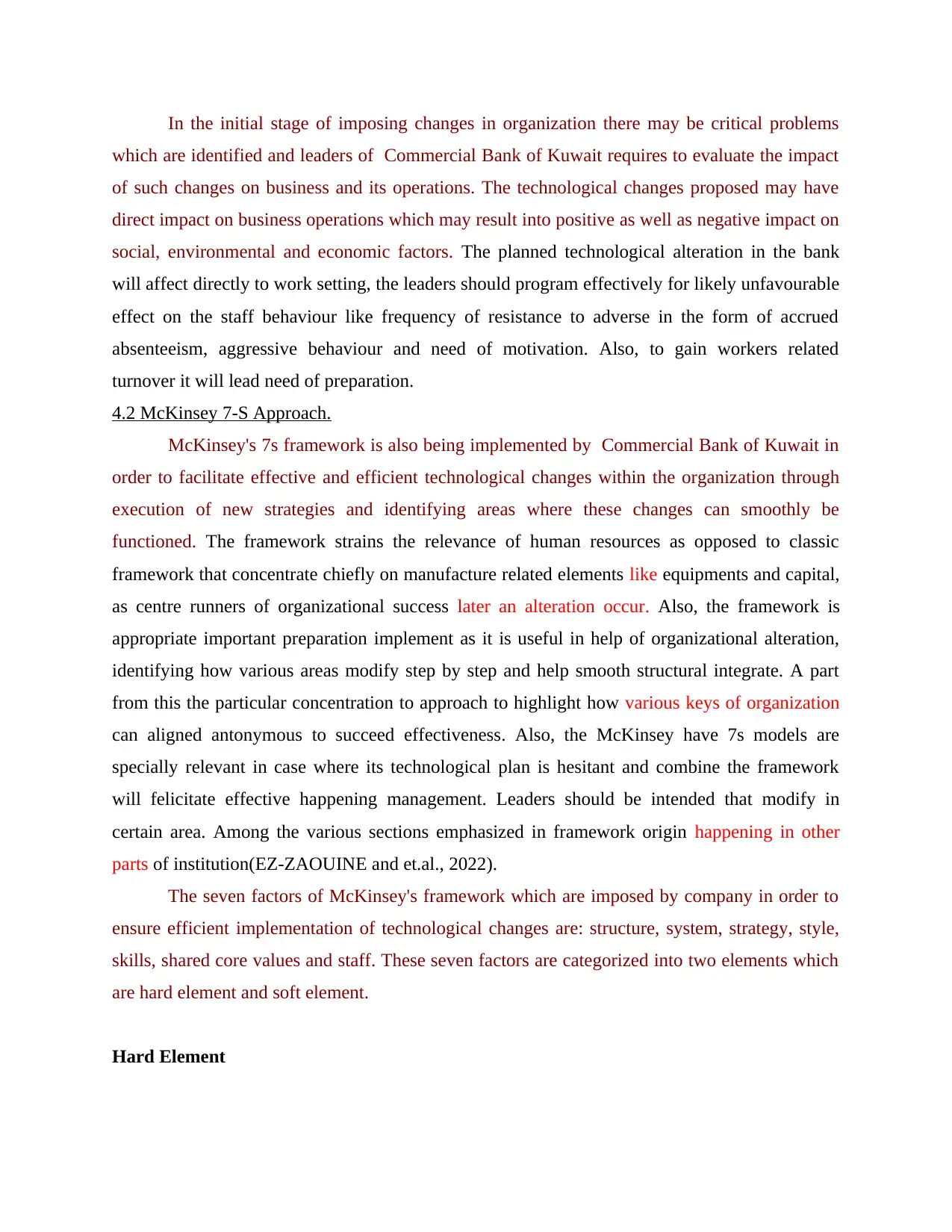
In the initial stage of imposing changes in organization there may be critical problems
which are identified and leaders of Commercial Bank of Kuwait requires to evaluate the impact
of such changes on business and its operations. The technological changes proposed may have
direct impact on business operations which may result into positive as well as negative impact on
social, environmental and economic factors. The planned technological alteration in the bank
will affect directly to work setting, the leaders should program effectively for likely unfavourable
effect on the staff behaviour like frequency of resistance to adverse in the form of accrued
absenteeism, aggressive behaviour and need of motivation. Also, to gain workers related
turnover it will lead need of preparation.
4.2 McKinsey 7-S Approach.
McKinsey's 7s framework is also being implemented by Commercial Bank of Kuwait in
order to facilitate effective and efficient technological changes within the organization through
execution of new strategies and identifying areas where these changes can smoothly be
functioned. The framework strains the relevance of human resources as opposed to classic
framework that concentrate chiefly on manufacture related elements like equipments and capital,
as centre runners of organizational success later an alteration occur. Also, the framework is
appropriate important preparation implement as it is useful in help of organizational alteration,
identifying how various areas modify step by step and help smooth structural integrate. A part
from this the particular concentration to approach to highlight how various keys of organization
can aligned antonymous to succeed effectiveness. Also, the McKinsey have 7s models are
specially relevant in case where its technological plan is hesitant and combine the framework
will felicitate effective happening management. Leaders should be intended that modify in
certain area. Among the various sections emphasized in framework origin happening in other
parts of institution(EZ-ZAOUINE and et.al., 2022).
The seven factors of McKinsey's framework which are imposed by company in order to
ensure efficient implementation of technological changes are: structure, system, strategy, style,
skills, shared core values and staff. These seven factors are categorized into two elements which
are hard element and soft element.
Hard Element
which are identified and leaders of Commercial Bank of Kuwait requires to evaluate the impact
of such changes on business and its operations. The technological changes proposed may have
direct impact on business operations which may result into positive as well as negative impact on
social, environmental and economic factors. The planned technological alteration in the bank
will affect directly to work setting, the leaders should program effectively for likely unfavourable
effect on the staff behaviour like frequency of resistance to adverse in the form of accrued
absenteeism, aggressive behaviour and need of motivation. Also, to gain workers related
turnover it will lead need of preparation.
4.2 McKinsey 7-S Approach.
McKinsey's 7s framework is also being implemented by Commercial Bank of Kuwait in
order to facilitate effective and efficient technological changes within the organization through
execution of new strategies and identifying areas where these changes can smoothly be
functioned. The framework strains the relevance of human resources as opposed to classic
framework that concentrate chiefly on manufacture related elements like equipments and capital,
as centre runners of organizational success later an alteration occur. Also, the framework is
appropriate important preparation implement as it is useful in help of organizational alteration,
identifying how various areas modify step by step and help smooth structural integrate. A part
from this the particular concentration to approach to highlight how various keys of organization
can aligned antonymous to succeed effectiveness. Also, the McKinsey have 7s models are
specially relevant in case where its technological plan is hesitant and combine the framework
will felicitate effective happening management. Leaders should be intended that modify in
certain area. Among the various sections emphasized in framework origin happening in other
parts of institution(EZ-ZAOUINE and et.al., 2022).
The seven factors of McKinsey's framework which are imposed by company in order to
ensure efficient implementation of technological changes are: structure, system, strategy, style,
skills, shared core values and staff. These seven factors are categorized into two elements which
are hard element and soft element.
Hard Element
⊘ This is a preview!⊘
Do you want full access?
Subscribe today to unlock all pages.

Trusted by 1+ million students worldwide
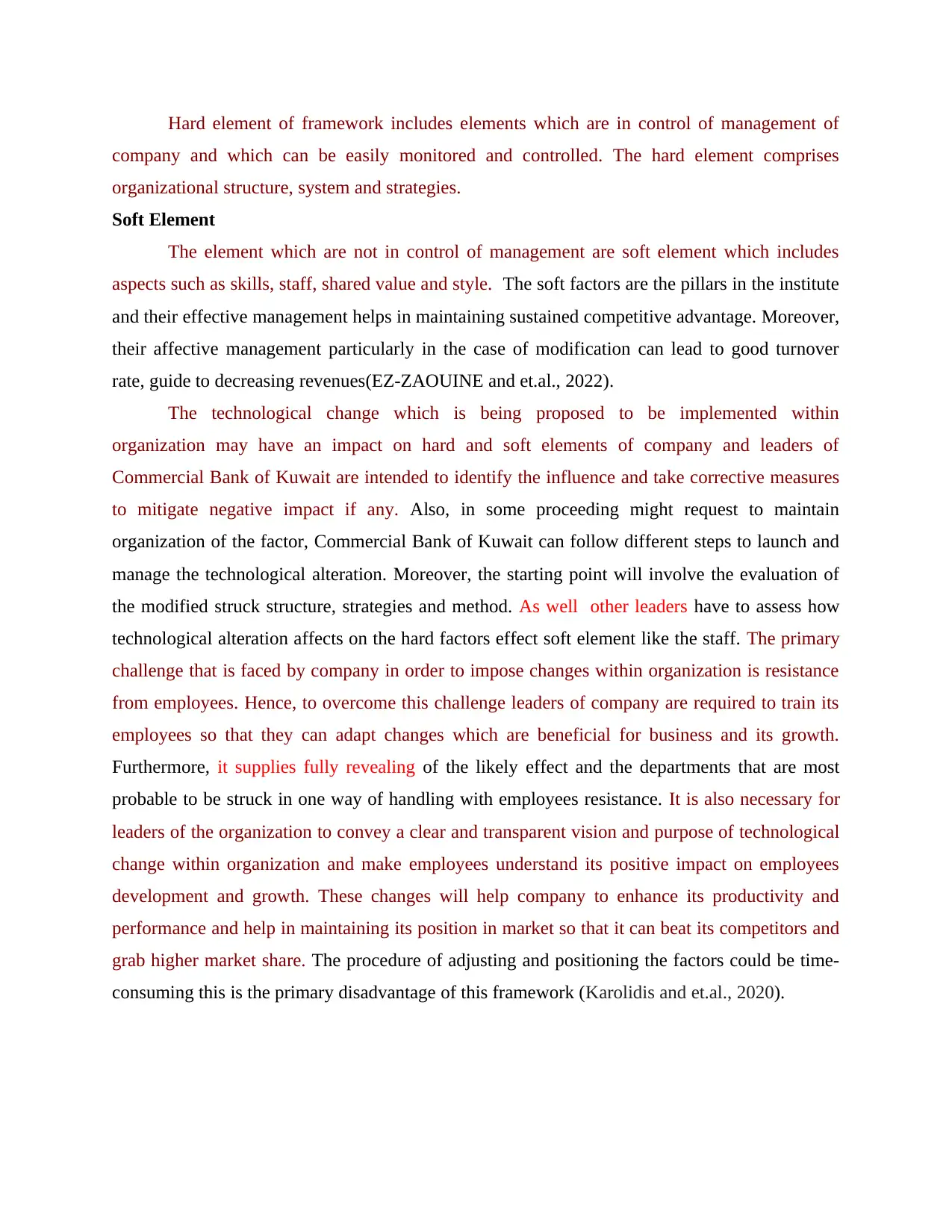
Hard element of framework includes elements which are in control of management of
company and which can be easily monitored and controlled. The hard element comprises
organizational structure, system and strategies.
Soft Element
The element which are not in control of management are soft element which includes
aspects such as skills, staff, shared value and style. The soft factors are the pillars in the institute
and their effective management helps in maintaining sustained competitive advantage. Moreover,
their affective management particularly in the case of modification can lead to good turnover
rate, guide to decreasing revenues(EZ-ZAOUINE and et.al., 2022).
The technological change which is being proposed to be implemented within
organization may have an impact on hard and soft elements of company and leaders of
Commercial Bank of Kuwait are intended to identify the influence and take corrective measures
to mitigate negative impact if any. Also, in some proceeding might request to maintain
organization of the factor, Commercial Bank of Kuwait can follow different steps to launch and
manage the technological alteration. Moreover, the starting point will involve the evaluation of
the modified struck structure, strategies and method. As well other leaders have to assess how
technological alteration affects on the hard factors effect soft element like the staff. The primary
challenge that is faced by company in order to impose changes within organization is resistance
from employees. Hence, to overcome this challenge leaders of company are required to train its
employees so that they can adapt changes which are beneficial for business and its growth.
Furthermore, it supplies fully revealing of the likely effect and the departments that are most
probable to be struck in one way of handling with employees resistance. It is also necessary for
leaders of the organization to convey a clear and transparent vision and purpose of technological
change within organization and make employees understand its positive impact on employees
development and growth. These changes will help company to enhance its productivity and
performance and help in maintaining its position in market so that it can beat its competitors and
grab higher market share. The procedure of adjusting and positioning the factors could be time-
consuming this is the primary disadvantage of this framework (Karolidis and et.al., 2020).
company and which can be easily monitored and controlled. The hard element comprises
organizational structure, system and strategies.
Soft Element
The element which are not in control of management are soft element which includes
aspects such as skills, staff, shared value and style. The soft factors are the pillars in the institute
and their effective management helps in maintaining sustained competitive advantage. Moreover,
their affective management particularly in the case of modification can lead to good turnover
rate, guide to decreasing revenues(EZ-ZAOUINE and et.al., 2022).
The technological change which is being proposed to be implemented within
organization may have an impact on hard and soft elements of company and leaders of
Commercial Bank of Kuwait are intended to identify the influence and take corrective measures
to mitigate negative impact if any. Also, in some proceeding might request to maintain
organization of the factor, Commercial Bank of Kuwait can follow different steps to launch and
manage the technological alteration. Moreover, the starting point will involve the evaluation of
the modified struck structure, strategies and method. As well other leaders have to assess how
technological alteration affects on the hard factors effect soft element like the staff. The primary
challenge that is faced by company in order to impose changes within organization is resistance
from employees. Hence, to overcome this challenge leaders of company are required to train its
employees so that they can adapt changes which are beneficial for business and its growth.
Furthermore, it supplies fully revealing of the likely effect and the departments that are most
probable to be struck in one way of handling with employees resistance. It is also necessary for
leaders of the organization to convey a clear and transparent vision and purpose of technological
change within organization and make employees understand its positive impact on employees
development and growth. These changes will help company to enhance its productivity and
performance and help in maintaining its position in market so that it can beat its competitors and
grab higher market share. The procedure of adjusting and positioning the factors could be time-
consuming this is the primary disadvantage of this framework (Karolidis and et.al., 2020).
Paraphrase This Document
Need a fresh take? Get an instant paraphrase of this document with our AI Paraphraser
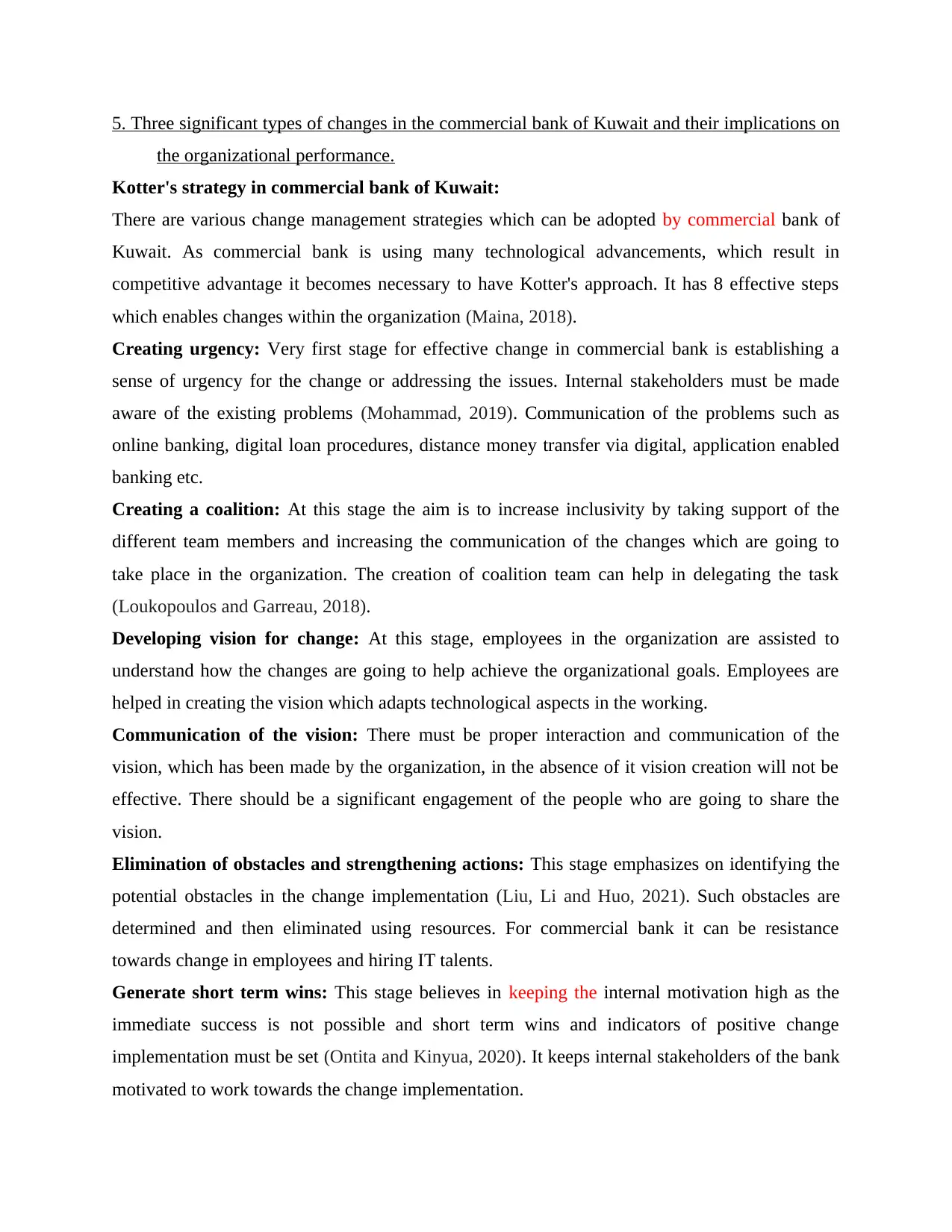
5. Three significant types of changes in the commercial bank of Kuwait and their implications on
the organizational performance.
Kotter's strategy in commercial bank of Kuwait:
There are various change management strategies which can be adopted by commercial bank of
Kuwait. As commercial bank is using many technological advancements, which result in
competitive advantage it becomes necessary to have Kotter's approach. It has 8 effective steps
which enables changes within the organization (Maina, 2018).
Creating urgency: Very first stage for effective change in commercial bank is establishing a
sense of urgency for the change or addressing the issues. Internal stakeholders must be made
aware of the existing problems (Mohammad, 2019). Communication of the problems such as
online banking, digital loan procedures, distance money transfer via digital, application enabled
banking etc.
Creating a coalition: At this stage the aim is to increase inclusivity by taking support of the
different team members and increasing the communication of the changes which are going to
take place in the organization. The creation of coalition team can help in delegating the task
(Loukopoulos and Garreau, 2018).
Developing vision for change: At this stage, employees in the organization are assisted to
understand how the changes are going to help achieve the organizational goals. Employees are
helped in creating the vision which adapts technological aspects in the working.
Communication of the vision: There must be proper interaction and communication of the
vision, which has been made by the organization, in the absence of it vision creation will not be
effective. There should be a significant engagement of the people who are going to share the
vision.
Elimination of obstacles and strengthening actions: This stage emphasizes on identifying the
potential obstacles in the change implementation (Liu, Li and Huo, 2021). Such obstacles are
determined and then eliminated using resources. For commercial bank it can be resistance
towards change in employees and hiring IT talents.
Generate short term wins: This stage believes in keeping the internal motivation high as the
immediate success is not possible and short term wins and indicators of positive change
implementation must be set (Ontita and Kinyua, 2020). It keeps internal stakeholders of the bank
motivated to work towards the change implementation.
the organizational performance.
Kotter's strategy in commercial bank of Kuwait:
There are various change management strategies which can be adopted by commercial bank of
Kuwait. As commercial bank is using many technological advancements, which result in
competitive advantage it becomes necessary to have Kotter's approach. It has 8 effective steps
which enables changes within the organization (Maina, 2018).
Creating urgency: Very first stage for effective change in commercial bank is establishing a
sense of urgency for the change or addressing the issues. Internal stakeholders must be made
aware of the existing problems (Mohammad, 2019). Communication of the problems such as
online banking, digital loan procedures, distance money transfer via digital, application enabled
banking etc.
Creating a coalition: At this stage the aim is to increase inclusivity by taking support of the
different team members and increasing the communication of the changes which are going to
take place in the organization. The creation of coalition team can help in delegating the task
(Loukopoulos and Garreau, 2018).
Developing vision for change: At this stage, employees in the organization are assisted to
understand how the changes are going to help achieve the organizational goals. Employees are
helped in creating the vision which adapts technological aspects in the working.
Communication of the vision: There must be proper interaction and communication of the
vision, which has been made by the organization, in the absence of it vision creation will not be
effective. There should be a significant engagement of the people who are going to share the
vision.
Elimination of obstacles and strengthening actions: This stage emphasizes on identifying the
potential obstacles in the change implementation (Liu, Li and Huo, 2021). Such obstacles are
determined and then eliminated using resources. For commercial bank it can be resistance
towards change in employees and hiring IT talents.
Generate short term wins: This stage believes in keeping the internal motivation high as the
immediate success is not possible and short term wins and indicators of positive change
implementation must be set (Ontita and Kinyua, 2020). It keeps internal stakeholders of the bank
motivated to work towards the change implementation.
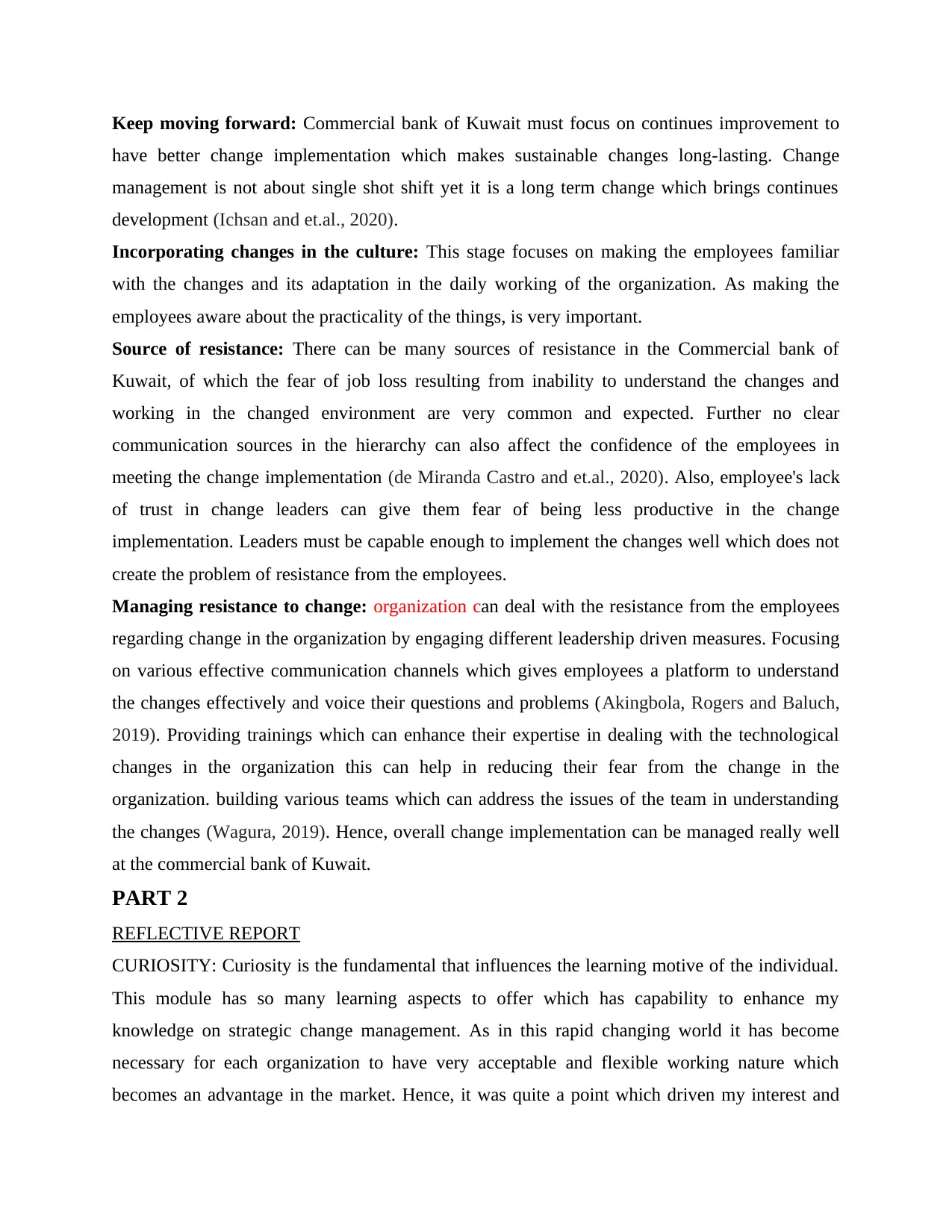
Keep moving forward: Commercial bank of Kuwait must focus on continues improvement to
have better change implementation which makes sustainable changes long-lasting. Change
management is not about single shot shift yet it is a long term change which brings continues
development (Ichsan and et.al., 2020).
Incorporating changes in the culture: This stage focuses on making the employees familiar
with the changes and its adaptation in the daily working of the organization. As making the
employees aware about the practicality of the things, is very important.
Source of resistance: There can be many sources of resistance in the Commercial bank of
Kuwait, of which the fear of job loss resulting from inability to understand the changes and
working in the changed environment are very common and expected. Further no clear
communication sources in the hierarchy can also affect the confidence of the employees in
meeting the change implementation (de Miranda Castro and et.al., 2020). Also, employee's lack
of trust in change leaders can give them fear of being less productive in the change
implementation. Leaders must be capable enough to implement the changes well which does not
create the problem of resistance from the employees.
Managing resistance to change: organization can deal with the resistance from the employees
regarding change in the organization by engaging different leadership driven measures. Focusing
on various effective communication channels which gives employees a platform to understand
the changes effectively and voice their questions and problems (Akingbola, Rogers and Baluch,
2019). Providing trainings which can enhance their expertise in dealing with the technological
changes in the organization this can help in reducing their fear from the change in the
organization. building various teams which can address the issues of the team in understanding
the changes (Wagura, 2019). Hence, overall change implementation can be managed really well
at the commercial bank of Kuwait.
PART 2
REFLECTIVE REPORT
CURIOSITY: Curiosity is the fundamental that influences the learning motive of the individual.
This module has so many learning aspects to offer which has capability to enhance my
knowledge on strategic change management. As in this rapid changing world it has become
necessary for each organization to have very acceptable and flexible working nature which
becomes an advantage in the market. Hence, it was quite a point which driven my interest and
have better change implementation which makes sustainable changes long-lasting. Change
management is not about single shot shift yet it is a long term change which brings continues
development (Ichsan and et.al., 2020).
Incorporating changes in the culture: This stage focuses on making the employees familiar
with the changes and its adaptation in the daily working of the organization. As making the
employees aware about the practicality of the things, is very important.
Source of resistance: There can be many sources of resistance in the Commercial bank of
Kuwait, of which the fear of job loss resulting from inability to understand the changes and
working in the changed environment are very common and expected. Further no clear
communication sources in the hierarchy can also affect the confidence of the employees in
meeting the change implementation (de Miranda Castro and et.al., 2020). Also, employee's lack
of trust in change leaders can give them fear of being less productive in the change
implementation. Leaders must be capable enough to implement the changes well which does not
create the problem of resistance from the employees.
Managing resistance to change: organization can deal with the resistance from the employees
regarding change in the organization by engaging different leadership driven measures. Focusing
on various effective communication channels which gives employees a platform to understand
the changes effectively and voice their questions and problems (Akingbola, Rogers and Baluch,
2019). Providing trainings which can enhance their expertise in dealing with the technological
changes in the organization this can help in reducing their fear from the change in the
organization. building various teams which can address the issues of the team in understanding
the changes (Wagura, 2019). Hence, overall change implementation can be managed really well
at the commercial bank of Kuwait.
PART 2
REFLECTIVE REPORT
CURIOSITY: Curiosity is the fundamental that influences the learning motive of the individual.
This module has so many learning aspects to offer which has capability to enhance my
knowledge on strategic change management. As in this rapid changing world it has become
necessary for each organization to have very acceptable and flexible working nature which
becomes an advantage in the market. Hence, it was quite a point which driven my interest and
⊘ This is a preview!⊘
Do you want full access?
Subscribe today to unlock all pages.

Trusted by 1+ million students worldwide
1 out of 18
Related Documents
Your All-in-One AI-Powered Toolkit for Academic Success.
+13062052269
info@desklib.com
Available 24*7 on WhatsApp / Email
![[object Object]](/_next/static/media/star-bottom.7253800d.svg)
Unlock your academic potential
Copyright © 2020–2025 A2Z Services. All Rights Reserved. Developed and managed by ZUCOL.





